MERCEDES-BENZ METRIS 2016 MY16 Operator’s Manual
Manufacturer: MERCEDES-BENZ, Model Year: 2016, Model line: METRIS, Model: MERCEDES-BENZ METRIS 2016Pages: 310, PDF Size: 7.28 MB
Page 51 of 310
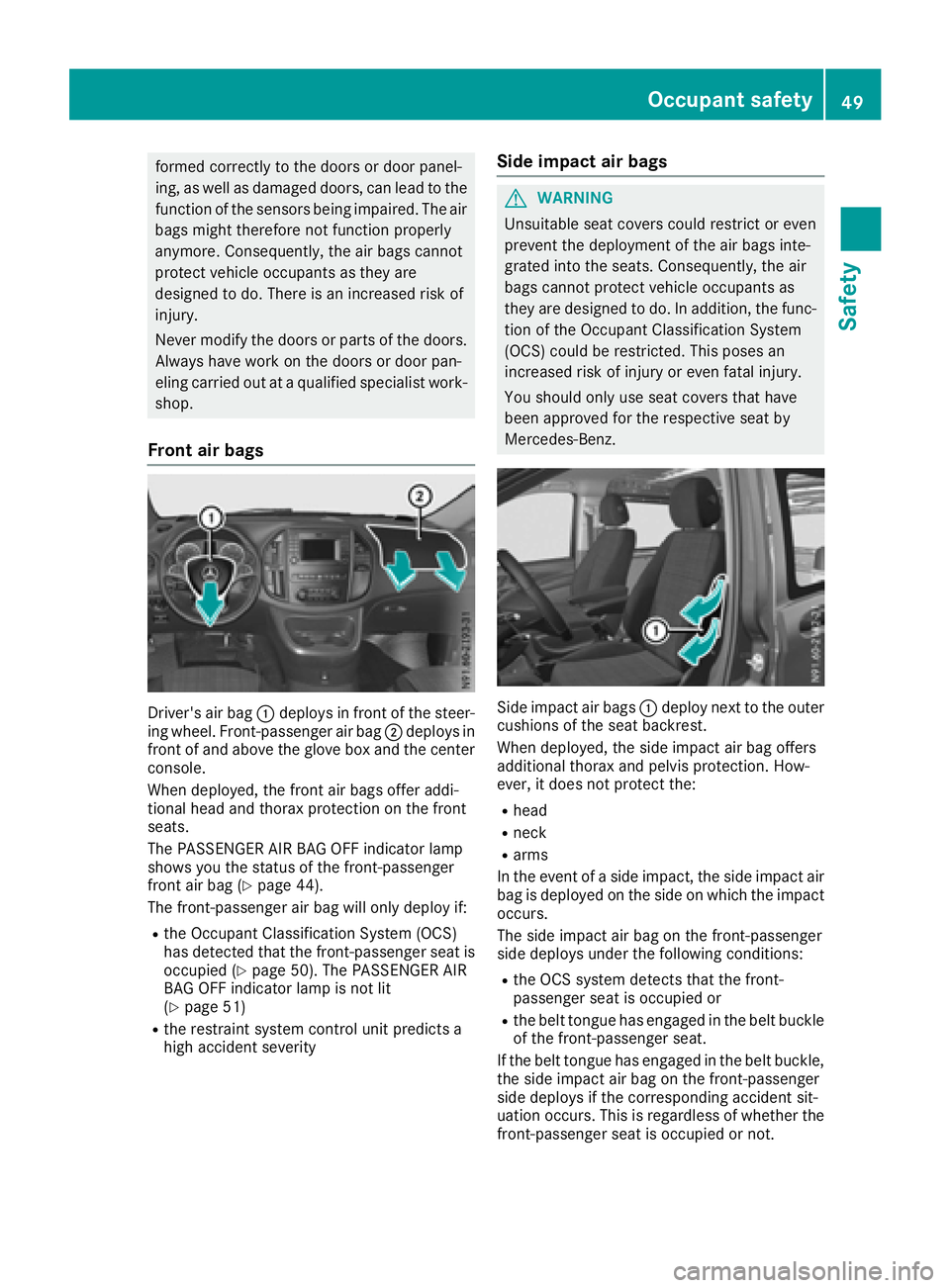
formed correctly to the doors or door panel-
ing, as wellasdamaged doors,c an leadtothe
function of the sensors being impaired .The air
bag smight therefore not function properly
anymore. Consequently, the air bag scannot
protect vehicl eoccupants as they are
designed to do. There is an increased risk of
injury.
Never modify the doors or parts of the doors. Always have work on the doors or door pan-
eling carrie dout at aqualified specialist work-
shop.
Fron tair bags
Driver's air bag :deploys in front of the steer-
ing wheel. Front-passenger air bag ;deploys in
front of and above the glove box and the center
console.
When deployed, the front air bag soffer addi-
tional heada nd thorax protection on the front
seats.
The PASSENGER AIR BAG OFF indicator lamp
showsy ou the status of the front-passenger
front air bag (
Ypag e44).
The front-passenger air bag wil lonly deploy if:
Rthe Occupant Classification System (OCS)
has detected that the front-passenger seati s
occupied (
Ypag e50). The PASSENGER AIR
BAG OFF indicator lam pisnot lit
(
Ypag e51)
Rthe restraint system control unit predicts a
high accident severity
Side impact air bags
GWARNING
Unsuitabl eseatc overs coul drestrict or even
prevent the deployment of the air bag sinte-
grated into the seats. Consequently, the air
bag scannot protect vehicl eoccupants as
they are designed to do. In addition, the func- tion of the Occupant Classification System
(OCS) coul dberestricted. This posesa n
increased risk of injury or even fatal injury.
You should only use seatc overs that have
been approved for the respective seatb y
Mercedes-Benz.
Side impact air bags :deploy next to the outer
cushions of the seatb ackrest.
When deployed, the side impact air bag offers
additiona lthorax and pelvis protection. How-
ever, it does not protect the:
Rhead
Rneck
Rarms
In the event of aside impact, the side impact air
bag is deploye donthe side on which the impact
occurs.
The side impact air bag on the front-passenger
side deploys under the following conditions:
Rthe OCS system detects that the front-
passenger seatiso ccupied or
Rthe belttongue has engaged in the beltb uckle
of the front-passenger seat.
If the beltt ongue has engaged in the beltb uckle,
the side impact air bag on the front-passenger
side deploys if the corresponding accident sit-
uation occurs. This is regardless of whethe rthe
front-passenger seatiso ccupied or not.
Occupant safety49
Safety
Z
Page 52 of 310
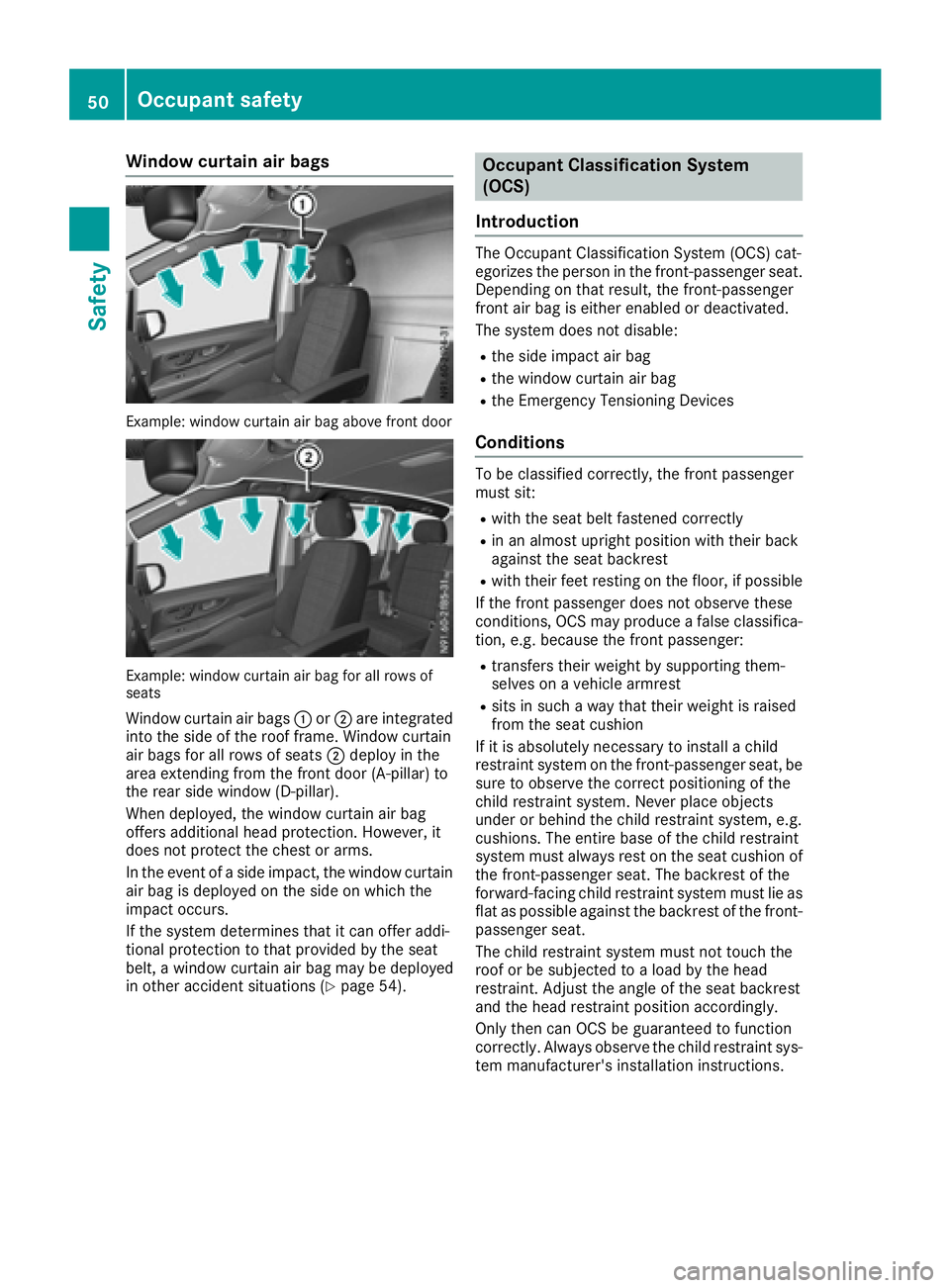
Windowcurtain air bags
Example:window curtai nair bag above front door
Example :window curtai nair bag for all rows of
seats
Windo wcurtai nair bags :or; are integrated
into the side of the roof frame. Windo wcurtain
air bag sfor all rows of seats ;deploy in the
area extending from the front door (A-pillar) to
the rear side window (D-pillar).
When deployed, the window curtai nair bag
offers additiona lheadp rotection. However, it
does not protect the chest or arms.
In the event of aside impact, the window curtain
air bag is deploye donthe side on which the
impact occurs.
If the syste mdetermines that it can offer addi-
tional protection to that provided by the seat
belt, awindow curtai nair bag may be deployed
in other accident situations (
Ypag e54).
Occupant Classificatio nSystem
(OCS)
Introduction
The Occupant Classification System (OCS) cat-
egorizes the personint he front-passenger seat.
Depending on that result, the front-passenger
front air bag is either enabled or deactivated.
The syste mdoes not disable:
Rthe side impact air bag
Rthe window curtai nair bag
Rthe Emergency Tensioning Devices
Conditions
To be classified correctly ,the front passenger
must sit:
Rwith the seatb eltfastened correctly
Rin an almost upright position with their back
against the seatb ackrest
Rwith their feet resting on the floor, if possible
If the front passenger does not observe these
conditions, OCS may produce afals ec lassifica-
tion, e.g. because the front passenger:
Rtransfers their weight by supporting them-
selve sonav ehiclea rmrest
Rsits in such awaythat their weight is raised
from the seatc ushion
If it is absolutely necessary to instal lachild
restraint syste monthe front-passenger seat, be
sure to observe the correct positioning of the
child restraint system. Never place objects
under or behind the child restraint system, e.g.
cushions. The entire bas eofthe child restraint
syste mmust alway srest on the seatc ushion of
the front-passenger seat. The backres tofthe
forward-facing child restraint syste mmust lie as
flat as possible against the backres tofthe front-
passenger seat.
The child restraint syste mmust not touch the
roof or be subjected to aloadbyt he head
restraint. Adjust the angl eofthe seatb ackrest
and the headr estraint position accordingly.
Only then can OCS be guaranteed to function
correctly .Always observe the child restraint sys-
tem manufacturer's installation instructions.
50Occupant safety
Safety
Page 53 of 310
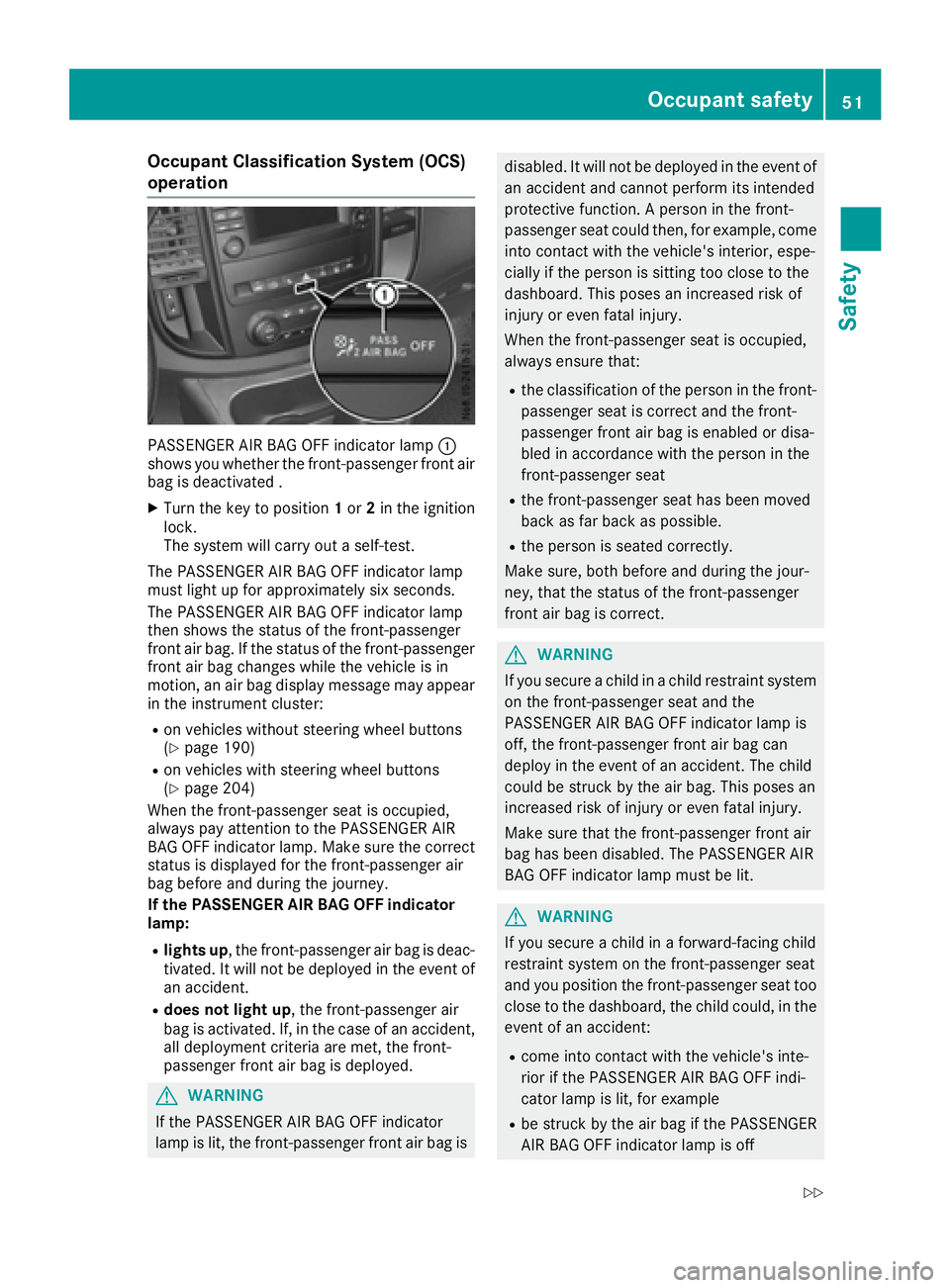
Occupant Classification System (OCS)
operation
PASSENGER AIR BAG OFF indicator lamp:
shows you whether the front-passenger fronta ir
bag is deactivated .
XTurn the key to position 1or 2in the ignition
lock.
The system will carry out aself-test.
The PASSENGER AIR BAG OFF indicator lamp
must light up for approximately six seconds.
The PASSENGER AIR BAG OFF indicator lamp
then shows the status of the front-passenger
fronta ir bag. If the status of the front-passenger
fronta ir bag changes while the vehicle is in
motion ,anair bag display message may appear
in the instrument cluster:
Ron vehicles without steering wheel buttons
(Ypage 190)
Ron vehicles with steering wheel buttons
(Ypage 204)
When the front-passenger seat is occupied,
alwaysp ay attention to the PASSENGER AIR
BAG OFF indicator lamp. Make sure the correct
status is displayed for the front-passenger air
bag before and during the journey.
If the PASSENGER AIR BAG OFF indicator
lamp:
Rlights up ,the front-passenger air bag is deac-
tivated. It will not be deployed in the event of
an accident.
Rdoes not light up,t he front-passenger air
bag is activated. If, in the case of an accident,
all deployment criteria are met, the front-
passenger fronta ir bag is deployed.
GWARNING
If the PASSENGER AIR BAG OFF indicator
lamp is lit, the front-passenger fronta ir bag is
disabled. It will not be deployed in the event of
an accidenta nd cannot perform its intended
protective function .Aperson in the front-
passenger seat could then ,for example, come
into contact with the vehicle's interior, espe-
cially if the person is sitting too close to the
dashboard. This poses an increased risk of
injur yore ven fatal injury.
When the front-passenger seat is occupied,
alwayse nsure that:
Rthe classification of the person in the front-
passenger seat is correct and the front-
passenger fronta ir bag is enabled or disa-
bled in accordance with the person in the
front-passenger seat
Rthe front-passenger seat has been moved
back as far back as possible.
Rthe person is seated correctly.
Make sure, both before and during the jour-
ney, that the status of the front-passenger
fronta ir bag is correct.
GWARNING
If you secure achild in achild restraint system
on the front-passenger seat and the
PASSENGER AIR BAG OFF indicator lamp is
off, the front-passenger fronta ir bag can
deploy in the event of an accident. The child
could be struc kbythe air bag. This poses an
increased risk of injur yoreven fatal injury.
Make sure that the front-passenger fronta ir
bag has been disabled. The PASSENGER AIR
BAG OFF indicator lamp must be lit.
GWARNING
If you secure achild in aforward-facing child
restraint system on the front-passenger seat
and you position the front-passenger seat too close to the dashboard, the child could, in the
event of an accident:
Rcome into contact with the vehicle's inte-
rior if the PASSENGER AIR BAG OFF indi-
cator lamp is lit, for example
Rbe struck by the air bag if the PASSENGER
AIR BAG OFF indicator lamp is off
Occupant safety51
Safety
Z
Page 54 of 310
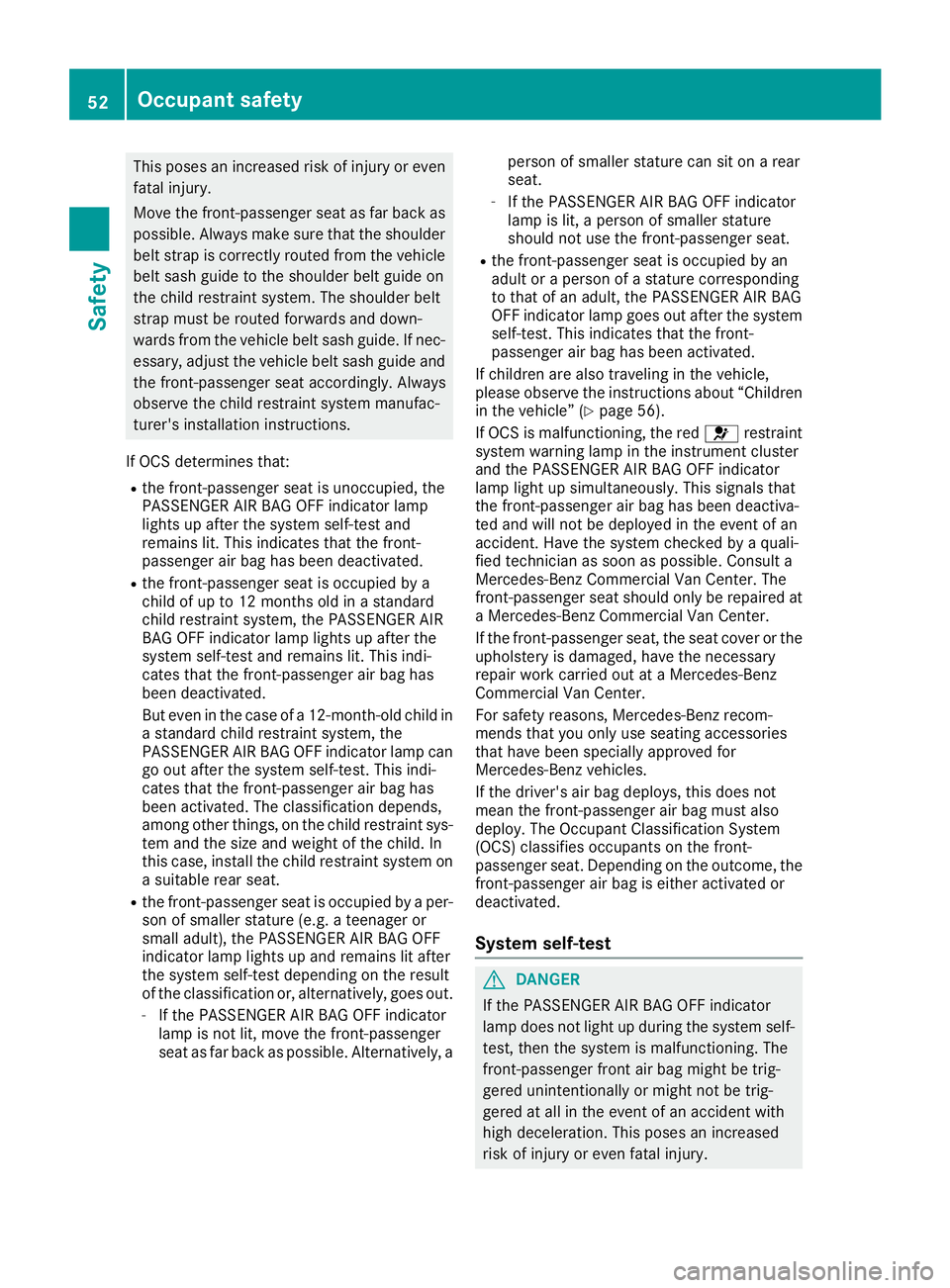
This poses an increased risk of injury or evenfatal injury.
Move the front-passenger seat as far back as
possible. Always make sure that the shoulder belt strap is correctly routed from the vehicle
belt sash guide to the shoulder belt guide on
the child restraint system. The shoulder belt
strap must be routed forwards and down-
wards from the vehicle belt sash guide. If nec-
essary, adjust the vehicle belt sash guide and
the front-passenger seat accordingly. Always
observe the child restraint system manufac-
turer's installation instructions.
If OCS determines that:
Rthe front-passenger seat is unoccupied, the
PASSENGER AIR BAG OFF indicator lamp
lights up after the system self-test and
remains lit. This indicates that the front-
passenger air bag has been deactivated.
Rthe front-passenger seat is occupied by a
child of up to 12 months old in astandard
child restraint system, the PASSENGER AIR
BAG OFF indicator lamp lights up after the
system self-test and remains lit. This indi-
cates that the front-passenger air bag has
been deactivated.
But even in the case of a12-month-old child in
as tandard child restraint system, the
PASSENGER AIR BAG OFF indicator lamp can
go out after the system self-test. This indi-
cates that the front-passenger air bag has
been activated. The classification depends,
among other things, on the child restraint sys-
tem and the size and weight of the child. In
this case, install the child restraint system on
as uitable rear seat.
Rthe front-passenger seat is occupied by aper-
son of smaller stature (e.g. ateenager or
small adult), the PASSENGER AIR BAG OFF
indicator lamp lights up and remains lit after
the system self-test depending on the result
of the classification or, alternatively, goes out.
-If the PASSENGER AIR BAG OFF indicator
lamp is not lit, move the front-passenger
seat as far back as possible. Alternatively, a person of smaller stature can sit on
arear
seat.
-If the PASSENGER AIR BAG OFF indicator
lamp is lit, aperson of smaller stature
should not use the front-passenger seat.
Rthe front-passenger seat is occupied by an
adult or aperson of astature corresponding
t o
that of an adult, the PASSENGER AIR BAG
OFF indicator lamp goes out after the system
self-test. This indicates that the front-
passenger air bag has been activated.
If children are also traveling in the vehicle,
please observe the instructions about “Children
in the vehicle” (
Ypage 56).
If OCS is malfunctioning, the red 6restraint
system warning lamp in the instrument cluster
and the PASSENGER AIR BAG OFF indicator
lamp light up simultaneously. This signals that
the front-passenger air bag has been deactiva-
ted and will not be deployed in the event of an
accident .Have the system checked by aquali-
fied technician as soon as possible. Consult a
Mercedes-Benz Commercial Van Center. The
front-passenger seat should only be repaired at aM ercedes-Benz Commercial Van Center.
If the front-passenger seat, the seat cover or the
upholstery is damaged, have the necessary
repair work carried out at aMercedes-Benz
Commercial Van Center.
For safety reasons, Mercedes-Benz recom-
mends that you only use seating accessories
that have been specially approved for
Mercedes-Benz vehicles.
If the driver's air bag deploys, this does not
mean the front-passenger air bag must also
deploy. The Occupant Classification System
(OCS) classifies occupantsont he front-
passenger seat. Dependin gonthe outcome, the
front-passenger air bag is either activated or
deactivated.
System self-test
GDANGER
If the PASSENGER AIR BAG OFF indicator
lamp does not light up during the system self-
test ,then the system is malfunctioning. The
front-passenger front air bag might be trig-
gered unintentionally or might not be trig-
gered at all in the event of an accident with
high deceleration. This poses an increased
risk of injury or even fatal injury.
52Occupant safety
Safety
Page 55 of 310
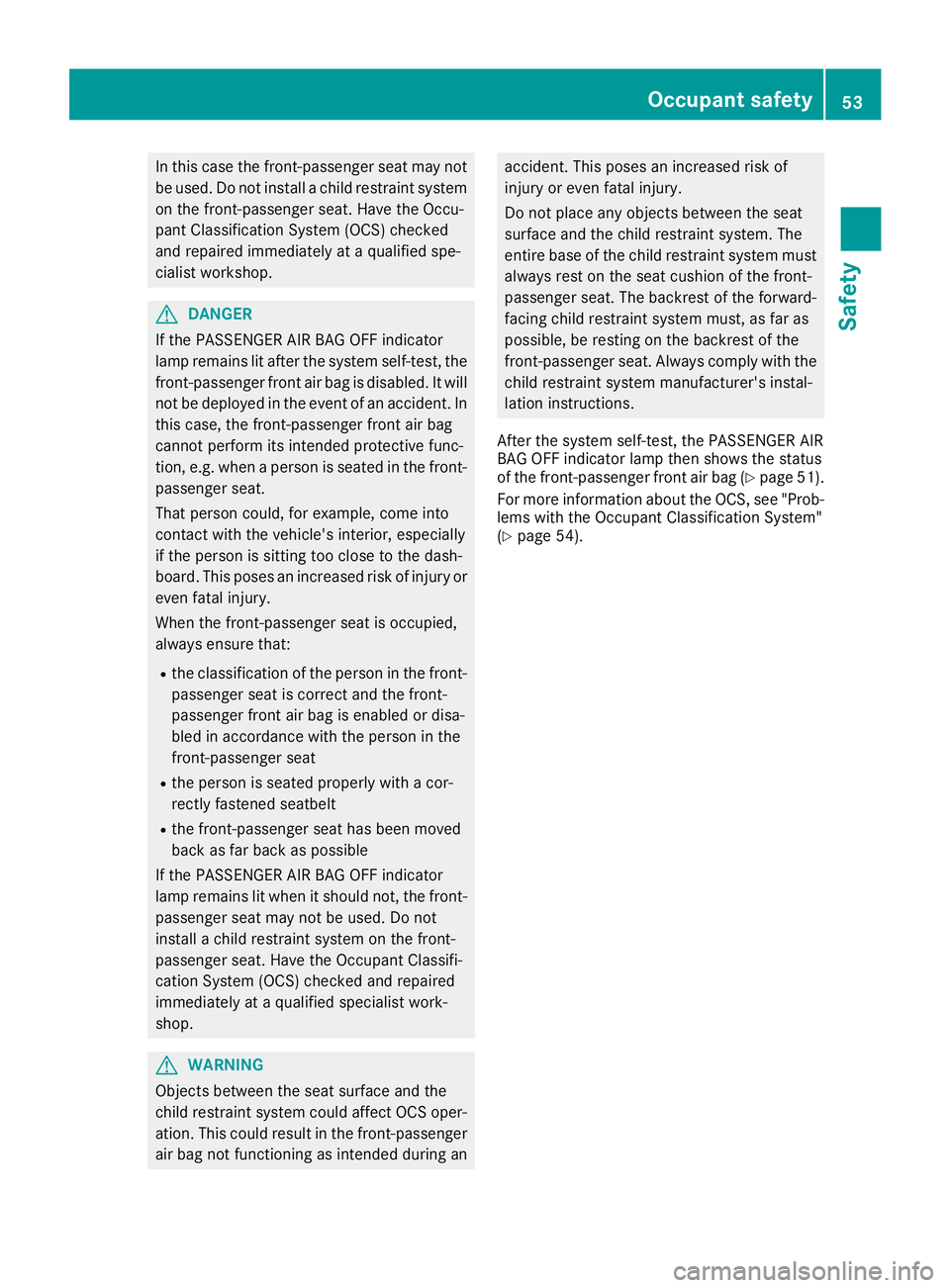
In this case the front-passenger seat may not
be used.Donot install achild restraint system
on the front-passenger seat. Have the Occu-
pant Classification System (OCS) checked
and repaired immediately at aqualifieds pe-
cialist workshop.
GDANGER
If the PASSENGER AIR BAG OFF indicator
lamp remains lit after the system self-test, the
front-passenger front air bag is disabled.Itw ill
not be deployed in the event of an accident. In
this case, the front-passenger front air bag
cannot perform its intended protective func-
tion, e.g. when aperson is seated in the front-
passenger seat.
That person could ,for example ,come into
contact with the vehicle's interior, especially
if the person is sitting too close to the dash-
board .This poses an increased risk of injury or
even fatal injury.
When the front-passenger seat is occupied,
always ensure that:
Rthe classification of the person in the front-
passenger seat is correct and the front-
passenger front air bag is enable dordisa-
bled in accordance with the person in the
front-passenger seat
Rthe person is seated properlyw ithacor-
rectly fastened seatbelt
Rthe front-passenger seat has been moved
back as far back as possible
If the PASSENGER AIR BAG OFF indicator
lamp remains lit when it shoul dnot, the front-
passenger seat may not be used .Donot
install achild restraint system on the front-
passenger seat. Have the Occupant Classifi-
cation System (OCS) checked and repaired
immediately at aqualifieds pecialist work-
shop.
GWARNING
Objects between the seat surface and the
child restraint system could affect OCS oper- ation. This could resul tinthe front-passenger
air bag not functioning as intended during an
accident. This poses an increased risk of
injury or even fatal injury.
Do not place any objects betwee nthe seat
surface and the child restraint system. The
entire base of the child restraint system must
always rest on the seat cushio nofthe front-
passenger seat. The backrest of the forward-
facing child restraint system must, as far as
possible, be resting on the backrest of the
front-passenger seat. Alway scomply with the
child restraint system manufacturer's instal-
lation instructions.
After the system self-test, the PASSENGER AIR
BAG OFF indicator lamp then shows the status
of the front-passenger front air bag (
Ypage 51).
For more information abou tthe OCS, see "Prob-
lems with the Occupant Classification System"
(
Ypage 54).
Occupant safety53
Safety
Z
Page 56 of 310
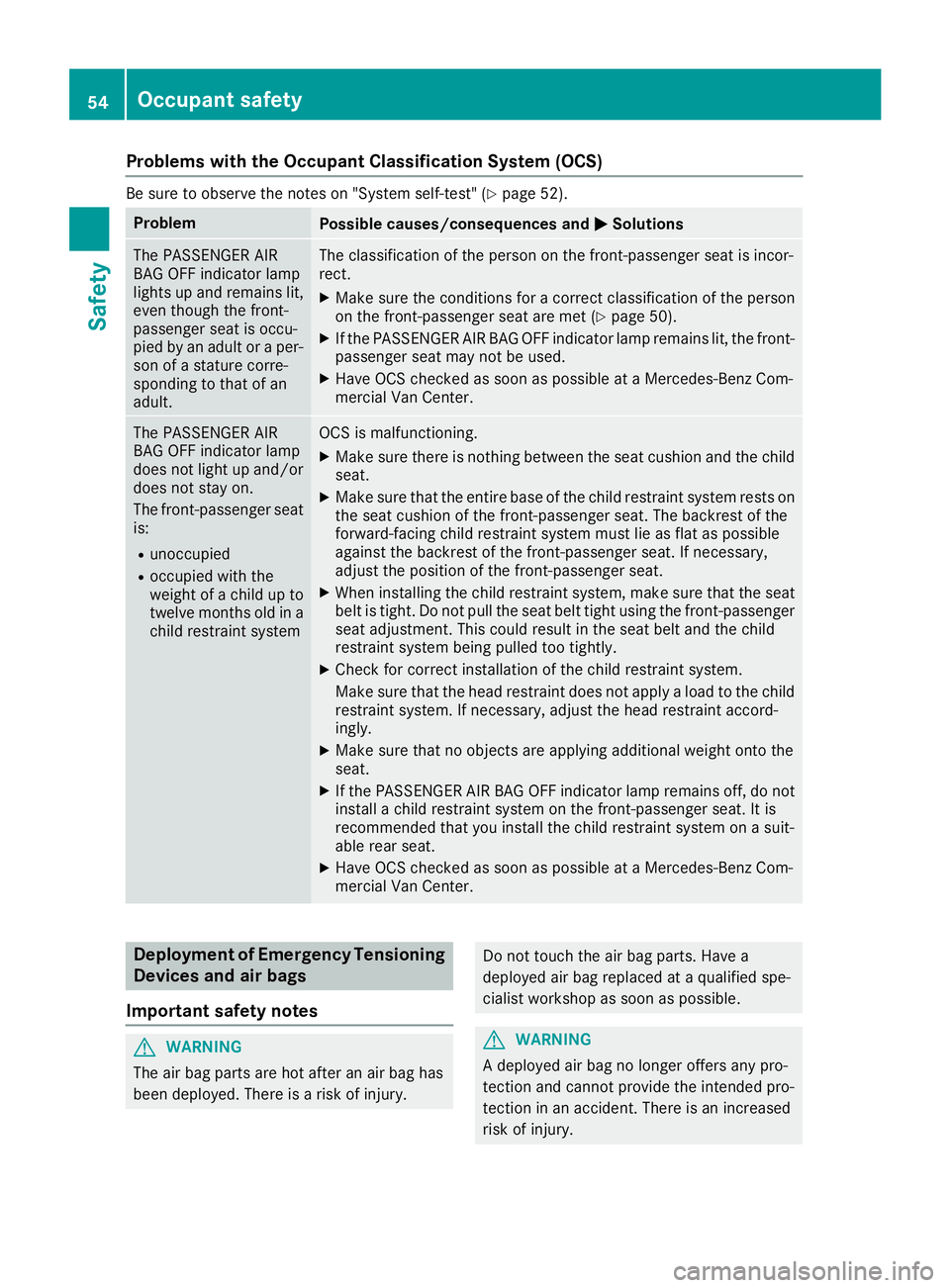
Problems with the Occupant Classification System (OCS)
Be sure to observe the notes on "System self-test"(Ypage 52).
ProblemPossible causes/consequences andMSolutions
The PASSENGER AIR
BAG OFF indicator lamp
lights up and remains lit,
even though the front-
passenger seat is occu-
pied by an adult oraper-
son of astature corre-
sponding to that of an
adult.The classification of the person on the front-passenger seat is incor-
rect.
XMake sure the conditionsf orac orrect classification of the person
on the front-passenger seat are met (Ypage 50).
XIf the PASSENGER AIR BAG OFF indicator lamp remains lit, the front-
passenger seat may not be used.
XHave OCS checked as soon as possible at aMercedes-Benz Com-
mercial Van Center.
The PASSENGER AIR
BAG OFF indicator lamp
does not light up and/or
does not stay on.
The front-passenger seat
is:
Runoccupied
Roccupied with the
weight of achild up to
twelve months old in a
child restraint system
OCS is malfunctioning.
XMake sure there is nothin gbetween the seat cushion and the child
seat.
XMake sure that the entire base of the child restraint system rests on
the seat cushion of the front-passenger seat. The backrest of the
forward-facing child restraint system must lie as flat as possible
against the backrest of the front-passenger seat. If necessary,
adjust the position of the front-passenger seat.
XWhen installing the child restraint system, make sure that the seat belt is tight. Do not pull the seat belt tight using the front-passenger
seat adjustment .This could result in the seat belt and the child
restraint system being pulled too tightly.
XCheck for correct installation of the child restraint system.
Make sure that the head restraint does not apply aload to the child
restraint system. If necessary, adjust the head restraint accord-
ingly.
XMake sure that no object sare applying additional weight onto the
seat.
XIf the PASSENGER AIR BAG OFF indicator lamp remains off, do not
install achild restraint system on the front-passenger seat. It is
recommended that you install the child restraint system on asuit-
able rear seat.
XHave OCS checked as soon as possible at aMercedes-Benz Com-
mercial Van Center.
Deployment of Emergency Tensioning
Devices and air bags
Important safety notes
GWARNING
The air bag parts are hot after an air bag has
been deployed. There is arisk of injury.
Do not touch the air bag parts. Have a
deploye dair bag replaced at aqualified spe-
cialist workshop as soon as possible.
GWARNING
Ad eployeda ir bag no longer offers any pro-
tection and cannot provide the intended pro-
tection in an accident. There is an increased
risk of injury.
54Occupant safety
Safety
Page 57 of 310
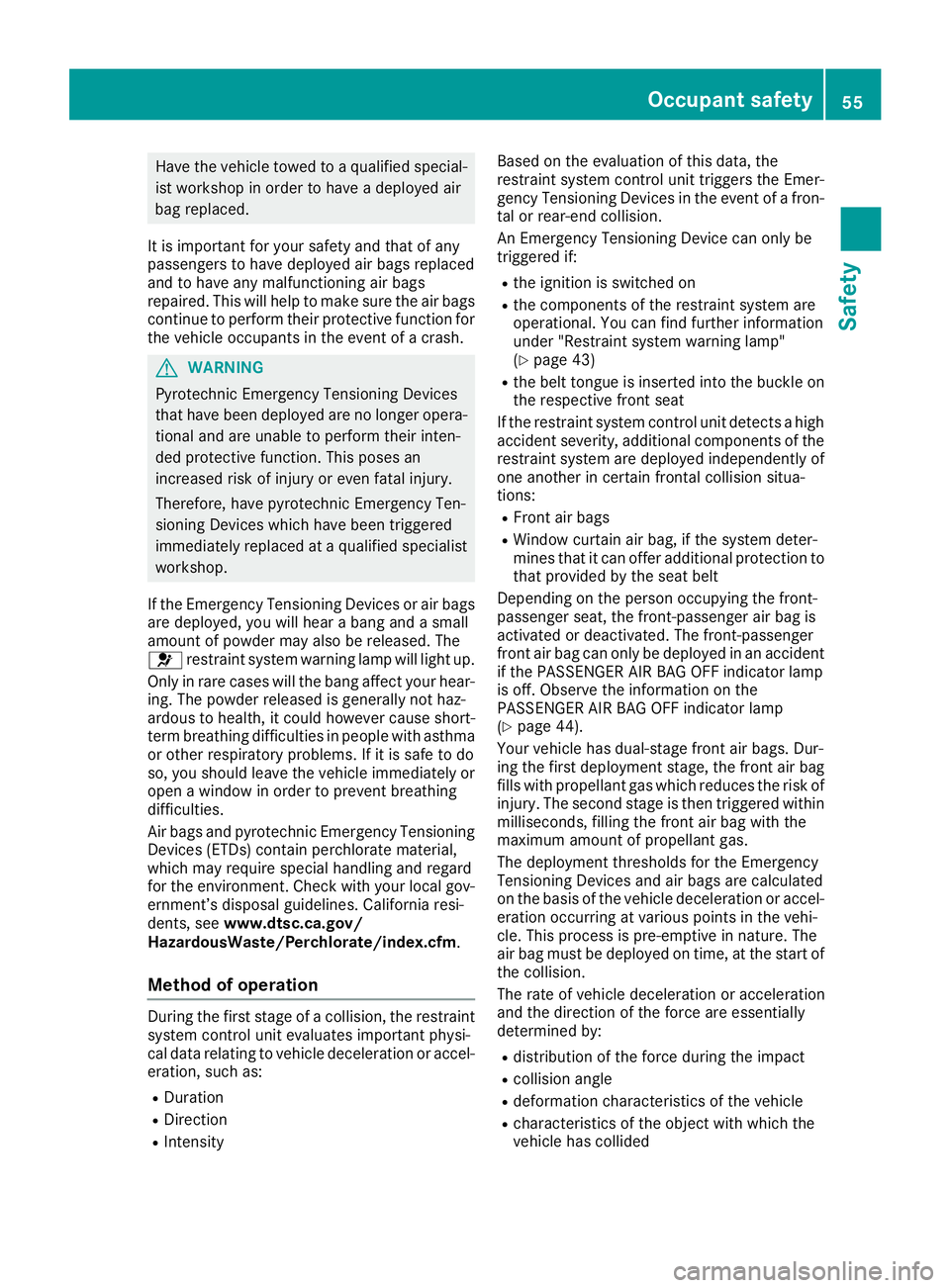
Have the vehicle towedtoaqualifiedspecial-
ist workshop in orde rtohavead eployed air
bagr eplaced.
It is important for your safety and that of any
passengers to hav edeployed ai rbagsr eplaced
and to hav eany malfunctioning ai rbags
repaired. Thisw illh elptom ake surethe ai rbags
continuetop erform theirp rotective functio nfor
the vehicle occupants in the event of acrash.
GWARNING
PyrotechnicE mergency Tensioning Devices
that hav ebeend eployed are no longer opera-
tiona land are unable to perform theiri nten-
ded protective function. Thisp oses an
increased risk of injury or even fata linjury.
Therefore, hav epyrotechnicE mergency Ten-
sioning Device swhich hav ebeent riggered
immediately replaced at aqualifie dspecialist
workshop.
If the Emergency Tensioning Device sorairbags
are deployed, yo uwillh earab angandasmall
amount of powder may also be released.T he
6 restraint system warning lamp will light up.
Only in rare case swillt he bang affect your hear-
ing. The powder released is generally not haz-
ardous to health, it coul dhowever cause short-
term breathing difficultie sinpeople with asthma
or other respiratory problems. If it is safe to do
so, yo ushould leave the vehicle immediately or
openaw indow in orde rtoprevent breathing
difficulties.
Air bags and pyrotechni cEmergency Tensioning
Device s(ETDs) contai nperchlorate material,
which may require specialh andling and regard
for the environment. Check with your loca lgov-
ernment’sd isposal guidelines .Calif ornia resi-
dents, see www.dtsc.ca.gov/
HazardousWaste/Perchlorate/index.cfm .
Methodofoperation
During the first stag eofacollision, the restraint
system control uni tevaluates important physi-
cal data relating to vehicle deceleratio noraccel-
eration, such as:
RDuration
RDirection
RIntensity Base
dont he evaluatio nofthis data, the
restraint system control uni ttriggers the Emer-
gency Tensioning Device sinthe event of afron-
tal or rear-end collision.
An Emergency Tensioning Device can only be
triggered if:
Rthe ignition is switched on
Rthe components of the restraint system are
operational .You can find furthe rinformation
unde r"Re straint system warning lamp"
(
Ypage 43)
Rthe bel ttongueisi nserted into the buckle on
the respective front seat
If the restraint system control uni tdetects ahigh
accident severity,a dditional components of the
restraint system are deployed independently of
one anothe rincertainfrontal collision situa-
tions:
RFront ai rbags
RWindow curtain ai rbag,ift he system deter-
mines that it can offer additional protection to
that provided by the seatb elt
Depending on the person occupying the front-
passenger seat, the front-passenger ai rbag is
activated or deactivated. The front-passenger
front ai rbag can only be deployed in an accident
if the PASSENGER AIR BAG OFF indicator lamp
is off. Observe the informatio nonthe
PASSENGER AIR BAG OFF indicator lamp
(
Ypage 44).
You rvehicle has dual-stage front ai rbags. Dur-
ing the first deployment stage, the front ai rbag
fills with propellant gas which reduces the risk of
injury .The second stag eisthen triggered withi
n
mi
lliseconds, filling the front ai rbag with the
maximum amount of propellant gas.
The deployment threshold sfor the Emergency
Tensioning Device sand ai rbagsa re calculated
on the basis of the vehicle deceleratio noraccel-
eration occurring at various points in the vehi-
cle. Thisp rocess is pre-emptiv einnature. The
ai rb ag mus tbed eployed on time, at the start of
the collision.
The rate of vehicle deceleratio noracceleration
and the directio nofthe force are essentially
determine dby:
Rdistribution of the force during the impact
Rcollision angle
Rdeformation characteristics of the vehicle
Rcharacteristics of the object with which the
vehicle has collided
Occupants afety55
Safety
Z
Page 58 of 310
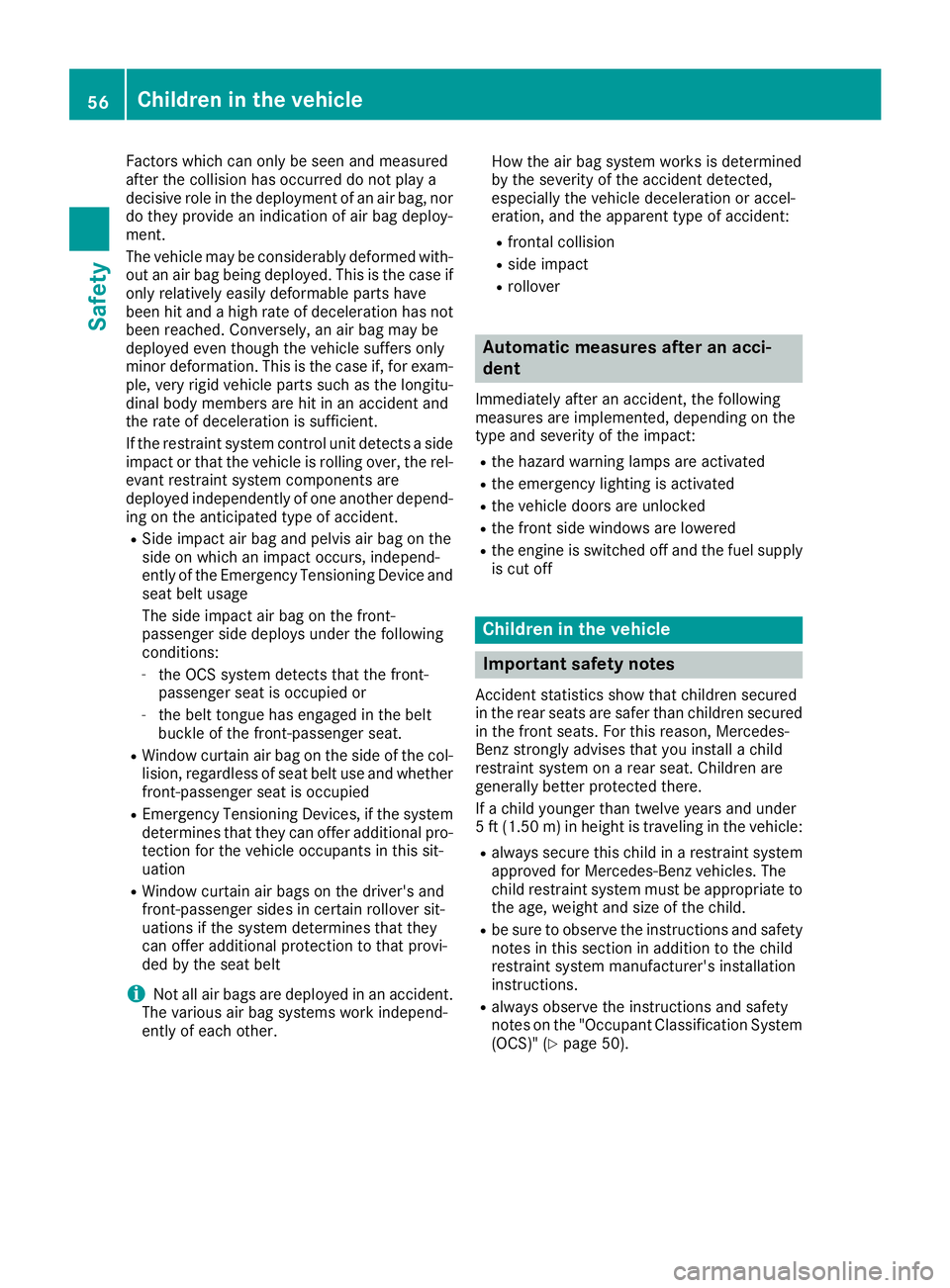
Factors which can only be seenand measured
afte rthe collision has occurred do not pla ya
decisive roleint he deployment of an ai rbag,nor
do they provide an indication of ai rbag deploy-
ment.
The vehicle may be considerably deformed with-
outana irbagb eing deployed. Thisist he case if
only relativelye asilyd eformable parts have
bee nhit and ahighr ate of deceleration has not
bee nreached .Conversely ,anairbagm ay be
deployed even though the vehicle suffers only
minor deformation. Thisist he case if, for exam-
ple ,very rigid vehicle parts such as the longitu-
dina lbodym embers are hit in an accident and
the rate of deceleration is sufficient.
If the restraint system control uni tdetects aside
impact or that the vehicle is rolling over,t he rel-
evant restraint system components are
deployed independently of one another depend-
ing on the anticipated typ eofaccident.
RSide impact ai rbag and pelvis ai rbag on the
sid eonw hich an impact occurs, independ-
ently of the Emergency Tensioning Device and sea tbeltu sage
The sid eimpact ai rbag on the front-
passenger sid edeploy sunder the following
conditions:
-the OCS system detects that the front-
passenger sea tisoccupied or
-the bel ttongueh as engaged in the belt
buckle of the front-passenger seat.
RWindow curtain ai rbag on the sid eofthe col-
lision, regardless of sea tbeltu se and whether
front-passeng er se
ati
so ccupied
REmergency Tensioning Devices, if the system
determinesthat they can offera dditional pro-
tection for the vehicle occupants in this sit-
uation
RWindow curtain ai rbagsont he driver's and
front-passenger sides in certain rollover sit-
uations if the system determine sthat they
can offera dditional protection to that provi-
ded by the sea tbelt
iNot al lairbags are deployed in an accident.
The variousa irbags ystems wor kindepend-
ently of each other. How the ai
rbag system works is determined
by the severity of the accident detected,
especiall ythe vehicle deceleration or accel-
eration, and the apparent typ eofaccident:
Rfrontalc ollision
Rsideimpact
Rrollover
Automatic measures after an acci-
dent
Immediately afte ranaccident, the following
measures are implemented ,depending on the
typ eand severity of the impact:
Rthe hazard warning lamps are activated
Rthe emergency lighting is activated
Rthe vehicle doors are unlocked
Rthe front sid ewindow sare lowered
Rthe engine is switched off and the fue lsupply
is cut off
Children in the vehicle
Important safety notes
Accident statistics show that childre nsecured
in the rears eats are safer than childre nsecured
in the front seats. For this reason, Mercedes-
Benz stronglya dvise sthat yo uinstall achild
restraint system on arears eat. Children are
generally better protected there.
If ac hildy ounge rthan twelve years and under
5ft( 1.50 m) in height is traveling in the vehicle:
Ralways securethisc hild in arestraint system
approved for Mercedes-Benz vehicles .The
child restraint systemm ustbea ppropriate to
the age, weight and size of the child.
Rbe sure to observe the instructions and safety
note sint hissectio nina dditiontot he child
restraint systemm anufacturer's installation
instructions.
Ralways observe the instructions and safety
note sont he "Occupant Classification System
(OCS) "(
Ypage 50).
56Children in the vehicle
Safety
Page 59 of 310
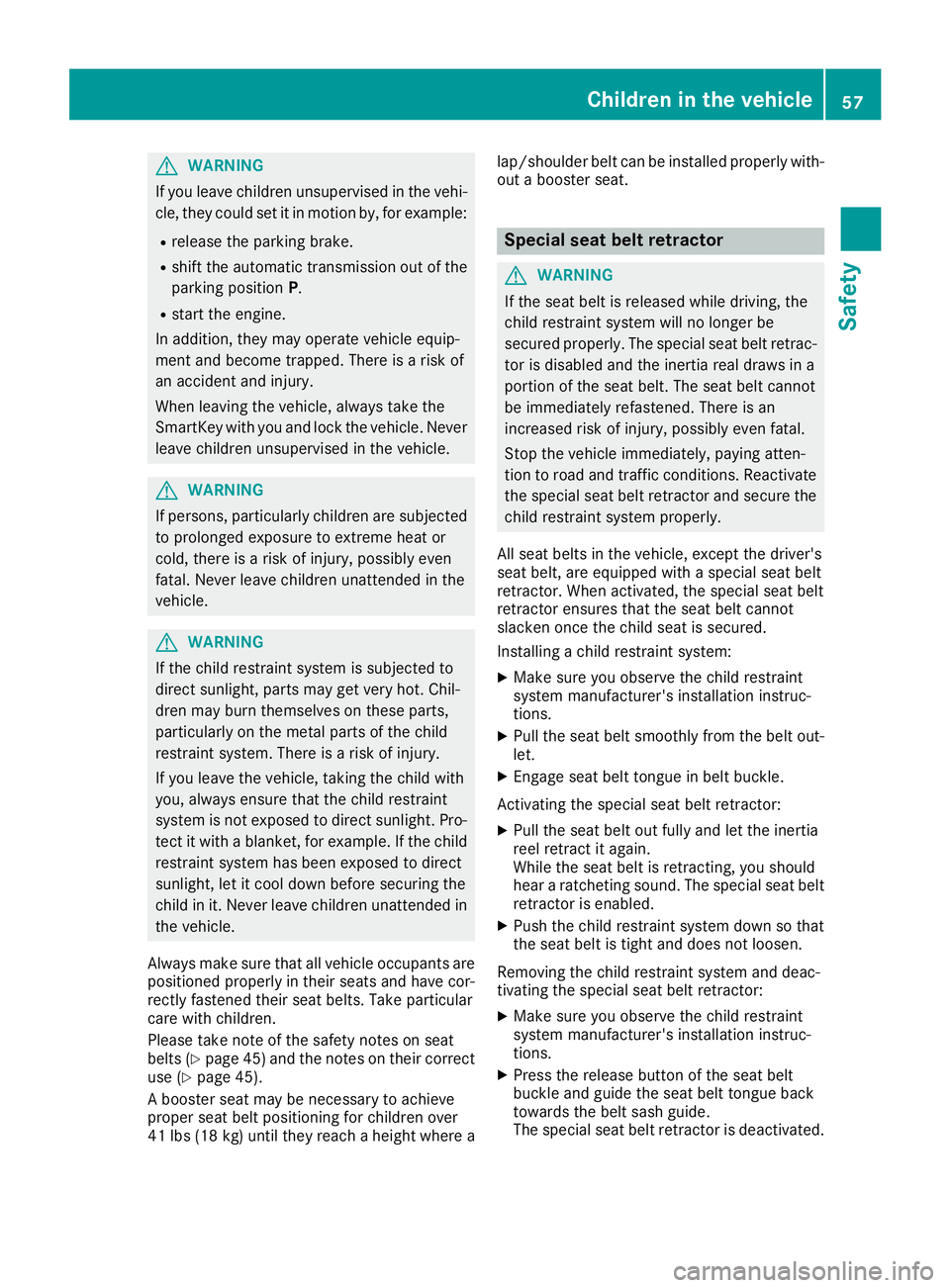
GWARNING
If you leave children unsupervised in the vehi-
cle, they coul dset it in motion by, for example:
Rrelease the parking brake.
Rshift the automatic transmission out of the
parking position P.
Rstart the engine.
In addition, they may operate vehiclee quip-
ment and become trapped. There is arisk of
an accident and injury.
When leaving the vehicle, alway stake the
SmartKey with you and lock the vehicle. Never
leave children unsupervised in the vehicle.
GWARNING
If persons, particularl ychildren are subjected
to prolonged exposure to extreme heato r
cold, there is arisk of injury ,possibly even
fatal .Never leave children unattended in the
vehicle.
GWARNING
If the child restraint system is subjected to
direct sunlight, parts may get very hot. Chil-
dren may burn themselves on these parts,
particularl yonthe metal parts of the child
restraint system. There is arisk of injury.
If you leave the vehicle, taking the child with
you ,alway sensure that the child restraint
system is not exposedtod irect sunlight. Pro-
tect it with ablanket, for example. If the child
restraint system has been exposedtod irect
sunlight, let it cool downb efore securing the
child in it. Never leave children unattended in
the vehicle.
Always make sure that all vehicleo ccupants are
positioned properly in their seats and have cor-
rectly fastened their seat belts. Take particular
care with children.
Please take note of the safety notes on seat
belts (
Ypag e45) and the notes on their correct
use (Ypag e45).
Ab ooster seat may be necessary to achieve
propers eat beltp ositioning for children over
41 lbs (18 kg )until they reach aheight where a lap/shoulder beltc
an be installed properly with-
out abooster seat.
Special seat bel tretractor
GWARNING
If the seat beltisr eleased while driving, the
child restraint system wil lnolonger be
secure dproperly.T he special seat beltr etrac-
tor is disableda nd the inertia real draw sina
portion of the seat belt. The seat beltc annot
be immediatel yrefastened. There is an
increased risk of injury ,possibly even fatal.
Stop the vehiclei mmediately, paying atten-
tion to road and traffic conditions. Reactivate
the special seat beltr etractor and secure the
child restraint system properly.
All seat belts in the vehicle, except the driver's
seat belt, are equipped with aspecial seat belt
retractor. When activated, the special seat belt
retractor ensure sthat the seat beltc annot
slacken once the child seat is secured.
Installing achild restraint system:
XMake sure you observe the child restraint
system manufacturer's installation instruc-
tions.
XPul lthe seat belts moothly from the belto ut-
let.
XEngage seat beltt ongue in beltbuckle.
Activating the special seat beltr etractor:
XPullthe seat belto ut fullyand let the inertia
reel retract it again.
Whil ethe seat beltisr etracting, you should
hear aratcheting sound .The special seat belt
retractor is enabled.
XPush the child restraint system downsot hat
the seat beltist ight and does not loosen.
Removing the child restraint system and deac-
tivating the special seat beltr etractor:
XMake sure you observe the child restraint
system manufacturer's installation instruc-
tions.
XPress the release button of the seat belt
buckle and guide the seat beltt ongue back
toward sthe belts ash guide.
The special seat beltr etractor is deactivated.
Children in the vehicle57
Safety
Z
Page 60 of 310
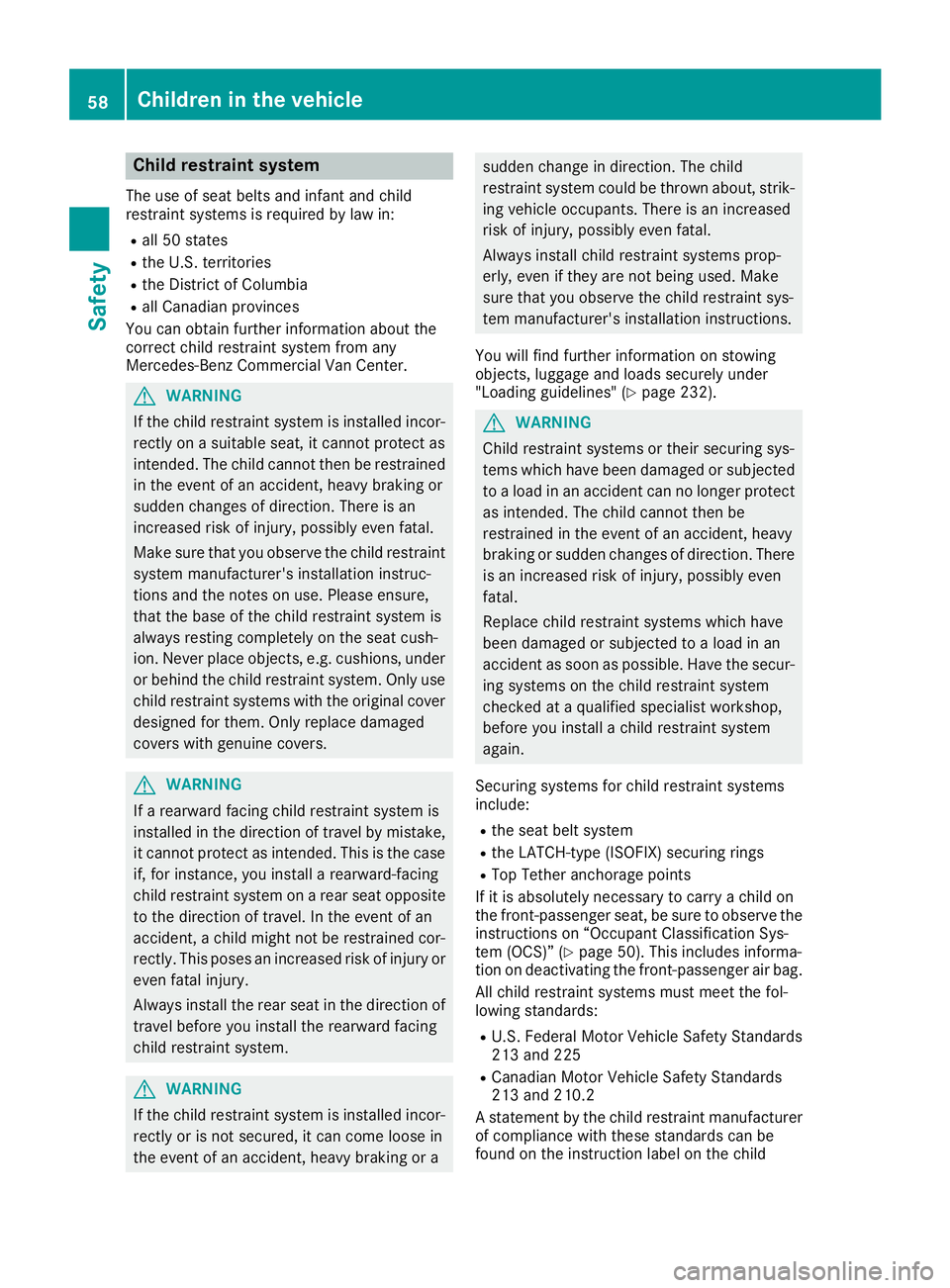
Child restraint system
The use of seat beltsand infant and child
restraint systems is required by law in:
Rall 50 states
Rth eU .S.t erri tories
RtheD istrict of Columbia
Rall Canadian provinces
You can obtain further informatio nabout the
correc tchild restraint system from any
Mercedes-Ben zCommercial Van Center.
GWARNING
If th echild restraint system is installed incor-
rectly on asuitable seat,itc annotprotect as
intended. The child canno tthe nber estrained
in th eevent of an accident, heavyb raking or
suddenc hanges of direction.T hereisan
increased ris kofinjury, possibly eve nfatal.
Makes ure that you observ ethe child restraint
system manufacturer'si nstallationinstruc-
tions and th enotes on use. Pleasee nsure,
that th ebase of th echild restraint system is
always restin gcompletely on th eseat cush-
ion.N ever placeo bjects, e.g.cushions, under
or behindt hechild restraint system. Only use
child restraint systems witht heoriginal cover
designe dfor them. Only replace damaged
covers withg enuine covers.
GWARNING
If ar earward facing child restraint system is
installed in th edirection of travel by mistake,
it canno tprotect as intended. This is th ecase
if, for instance, you install arearward-facing
child restraint system on arear seat opposite
to th edirection of travel. In th eevent of an
accident, achild migh tnotbe restraine dcor-
rectly. This posesani ncreased riskofinjury or
eve nfatal injury.
Always install th erear seat in th edirection of
travel before you install th erearward facing
child restraint system.
GWARNING
If th echild restraint system is installed incor-
rectly or is no tsecured, it can com eloosei n
th ee vent of an accident, heavyb raking or a
suddenchang eind irection.T he child
restraint system coul dbethrown about,s trik-
ing vehicle occupants .Thereisani ncreased
ris kofi njury, possibly eve nfatal.
Always install child restraint systems prop-
erly, eve niftheya re no tbeingu sed. Make
sure that you observ ethe child restraint sys-
te mm anufacturer'si nstallationinstructions.
You will fin dfurther informatio nonstowing
objects, luggagea nd loads securely under
"Loading guidelines" (
Ypage 232).
GWARNING
Child restraint systems or their securin gsys-
tems whichh ave been damaged or subjected
to aload in an accidentc an no longer protect
as intended. The child canno tthe nb e
restraine dintheevent of an accident, heavy
braking or suddenc hanges of direction.T here
is an increased ris kofinjury, possibly even
fatal.
Replacec hild restraint systems whichh ave
been damaged or subjected to aload in an
accidentass oon as possible. Hav ethe secur-
ing systems on th echild restraint system
checked at aqualified specialist workshop,
before you install achild restraint system
again.
Securin gsystems for child restraint systems
include:
Rth es eat belt system
RtheL ATCH-type (ISOFIX) securin grings
RTop Tether anchorage points
If it is absolutely necessary to carry achild on
th ef ront-pa ssenger seat,bes ure to observethe
instructionson“ OccupantClassificatio nSys-
te m( OCS)” (
Ypage 50). This includes informa-
tio nond eactivatin gthe front-passenger air bag.
All child restraint systems must mee tthe fol-
lowings tandards:
RU.S. Federal Motor Vehicle SafetyS tandards
21 3a nd 225
RCanadian Motor Vehicle SafetyS tandards
21 3a nd 210.2
As tatemen tbythechild restraint manufacturer
of compliance witht hese standards can be
foun dont heinstruction label on th
ec hild
58Children in th evehicle
Safety